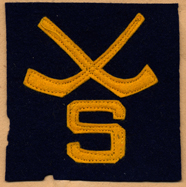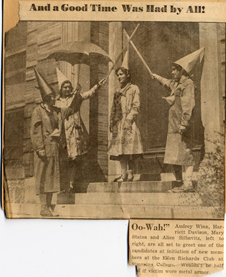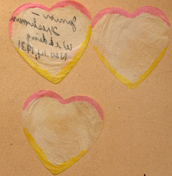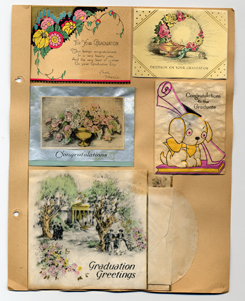Caroline's Life

Caroline (called "Cal" by her friends) Stokes was one of a set of twins from Wakefield Massachusetts. Her twin brother James attended Wentworth College, as Simmons College undergraduate programs are exclusively for women.

Caroline majored in biology and chemistry, and spent time out of class pursuing athletics; she lettered in hockey and was a member of the Simmons College Athletic Association (SAA) throughout her college tenure.
She maintained an active social life outside classes and sports, attending dances and gatherings on campus. Caroline nurtured thriving friendships with her fellow students, keeping up with her friends' accomplishments and attending their weddings after graduation. She served as president of her senior class in 1933. Caroline participated in student Catholic clubs and remaining a devout Catholic throughout her life. It was noted by a newspaper that, in her later years, she had been active within a benevolent society that worked for the good of her church.
She went on to become a chemistry teacher and then spent her career as a technician at the General Electric Company River Works.
Cal's Life at Simmons

Each graduating class at Simmons had its own colors and official mascot. Caroline's class, graduating 1933, used blue and yellow; their mascot was the duck.
She actively participated in campus traditions and and school events, many of which are still practiced on campus today. She actively participated in campus traditions and and school events. Some of the Simmons activities in which Caroline took part were the freshman/junior wedding, track day, floor teas, and May day. Of the many traditions that helped perpetuate the legacy of Simmons sisterhood, a few still survive today. There are still weekly "floor snacks" in the residence halls, and sporting events that celebrate school spirit, such as the Simmons Cup, an annual field day in which residence halls compete to see who has the most school spirit. Now as well as in Cal’s time, Simmons traditions have led to cherished memories (and colorful scrapbooks!).
The Simmons Freshman-Junior Wedding was one example of an annual Simmons tradition; the freshman class president dressed as the bride, and the Junior class president dressed as the groom. These two women were then wed “until graduation do us part." Maybe not a traditional wedding, but the Simmons girls enjoyed the annual celebration!
The most popular majors at the time were secretarial studies and nursing, but Caroline knew she wanted to work as a scientist and labored to make that goal a reality. She became a member of the Ellen Richards Club, an honor society for students in the sciences.

According to a Boston Globe article about her induction into the club, she participated fully in the academic and social life of the school. A newspaper article from 1931 describes the induction of new members to the Ellen Richards Club this way: "The girls walked Simmons' halls in handmade costumes of dunce caps, umbrellas and all manner of laboratory paraphernalia."
There are still weekly "floor snacks" in the residence halls, and sporting events that celebrate school spirit, such as the Simmons Cup, an annual field day in which residence halls compete to see who has the most school spirit. Now as in Cal’s time, Simmons traditions provide excellent fodder for cherished memories (and colorful scrapbooks!).
Commencement:

Much of Cal’s scrapbook contains commencement memorabilia. Graduation was important as both a celebration and a ceremony. The Baccalaureate service was held in the afternoon on the first day of commencement weekend, followed by a reception for seniors, alumnae, faculty, and guests. Commencement was held the day following the service. Cal graduated in a senior class of 232 “girls,” as they were called in the programs. There were 318 candidates for Bachelor of Science degrees at her Commencement and an additional 21 Master of Science degrees.
Cal’s own graduation was celebrated by her friends and family, as evidenced by the multitude of congratulatory messages and cards sent to her, which she saved in her scrapbook.

General Electric Riverworks
Unlike many of her peers, Caroline never married; she was able to support herself by working at the General Electric Company, where she was able to put her Simmons degree in biology and chemistry to good use. She worked at the Riverworks plant in Lynn, Massachusetts, which was the company headquarters at the time. It is still part of GE’s aviation division.
The Riverworks plant in Lynn was built in the 1800s by the Thomson-Houston Company, which later merged with Edison General Electric Company to become General Electric in 1892. It manufactured metal and electrical products—turbines, generators, engines, lighting, gears, and other products that supported the growth of electricity in America. Gradually, the focus of the plant shifted from “electrics in general” to aviation. The River Works plant was entrusted with a superturbocharger project that put GE on the U.S. military’s desired list.
Caroline began working at the plant around 1935. Shortly thereafter, in 1941, the Lynn plant was elected to build a jet engine for the U.S. Army Air Corps. It took them 6 months to develop the I-A engine, America’s first jet engine. Over the next two years, Riverworks continued to improve the engine; the J33 powered the Air Corps’ first operational jet fighter in 1947. This is a project Caroline would have probably been involved in developing.
Concerned that GE’s new focus on jet engines would threaten the supply of turbosuperchargers, the product for which GE had primarily been known prior to their jet engine developing days, the military gave GE’s plans to other manufacturers. However, GE continued to work on their own engines, and the next version, a J47, put the company back in the jet engine building business. From then on, the plant was allowed to continue developing, building, and selling jet engines; it was clear that their research excelled.
In 1949, GE moved part of their jet engine manufacturing to a new plant in Cincinnati, Ohio, since the Lynn plant was too small to meet the military's growing demands. A few years later, that plant would take over as GE Aviation Division’s headquarters, but River Works is still in operation today.
Sources
Obituary of Caroline F. Stokes, accessed through ancestry.com on Feb. 7, 2011 Thu Oct 16, 2008, 05:20 PM EDT Saugus Advertiser, 72 Cherry Hill Drive, Beverly, MA 01915
ELLEN RICHARDS CLUB OF SIMMONS COLLECE CONDUCTS ITS ANNUAL INITIATION CEREMONIES. (1931, April 10). Daily Boston Globe (1928-1960),36. Retrieved February 9, 2011, from ProQuest Historical Newspapers Boston Globe (1872 - 1979). (Document ID: 2020495422).
